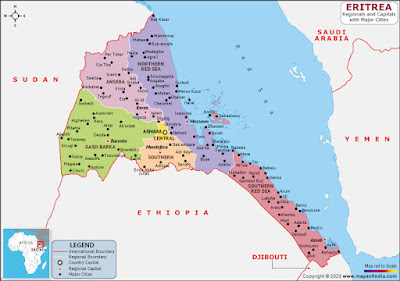Eritrea, a beautiful and often overlooked country in the Horn of Africa, offers travelers stunning Red Sea coastlines, unique colonial architecture, dramatic highlands, and a rich blend of cultures. From the art deco streets of Asmara to the Dahlak Archipelago’s coral reefs, Eritrea is a destination for those seeking authentic, unspoiled experiences.
Discover Eritrea
📍 Location: Situated in the Horn of Africa, bordered by Sudan, Ethiopia, Djibouti, and the Red Sea.
🌊 Coastal Beauty: The Red Sea coast is dotted with pristine beaches and islands ideal for diving and snorkeling.
⛰️ Highlands and Lowlands: Eritrea’s landscape includes cool highlands, hot coastal plains, and the vast Danakil Depression.
🏛️ Historical Crossroads: Influences from African, Arab, and Italian cultures shape Eritrea’s unique identity.
Top Places to Visit in Eritrea
🏙️ Asmara: The capital city, known for its well-preserved Italian Art Deco architecture, lively cafes, and relaxed atmosphere.
🏝️ Dahlak Archipelago: A group of over 100 islands in the Red Sea, ideal for diving, snorkeling, and exploring marine life.
🏞️ Massawa: A historic port city with Ottoman and Italian architecture, coral-built houses, and nearby beaches.
⛰️ Keren: A highland town surrounded by mountains, famous for its Monday camel market and Italian war cemetery.
🏜️ Danakil Depression: Explore the Afar region’s salt flats and volcanic landscapes.
Culture and Traditions
✨ Ethnic Diversity: Home to nine recognized ethnic groups, including Tigrinya, Tigre, Afar, and Saho, each with distinct languages and traditions.
✨ Religious Harmony: Christianity and Islam are the major religions, with peaceful coexistence reflected in daily life.
✨ Italian Influence: Visible in architecture, cuisine, and café culture, a remnant of Eritrea’s colonial past.
✨ Traditional Music and Dance: Eritrean music blends African rhythms with Middle Eastern melodies.
Eritrean Cuisine
🍝 Pasta: A popular dish due to Italian influence, often served with spicy sauces.
🥘 Zigni: A spicy meat stew served with injera (flat sourdough bread).
🍚 Ful: A breakfast dish made from mashed fava beans with spices.
🥖 Himbasha: Sweet, spiced bread often served during festivals.
☕ Coffee Ceremony: Coffee holds cultural significance, often served in traditional ceremonies.
Why Visit Eritrea?
✅ Architectural Beauty: Asmara is a UNESCO World Heritage Site for its Art Deco architecture.
✅ Diving and Snorkeling: The Dahlak Archipelago offers untouched marine environments.
✅ Cultural Richness: Diverse ethnic traditions and welcoming hospitality.
✅ Historic Sites: Ottoman and Italian architecture in Massawa and other regions.
✅ Adventure: Hike highland trails, explore the Danakil Depression, or visit ancient ruins.
Practical Travel Tips
🛂 Visa: Required for most visitors; best arranged before travel.
🌤️ Best Time to Visit: October to March for cooler, pleasant weather.
🗣️ Language: Tigrinya, Arabic, and English are widely spoken.
👗 Dress Modestly: Light, modest clothing is recommended, respecting cultural norms.
Final Thoughts 🌍✨
Eritrea is a country of hidden beauty and quiet charm, offering a blend of cultural depth, historic architecture, and natural wonders. Whether you wish to sip espresso in an Asmara café, dive into the clear waters of the Red Sea, or explore the highlands and deserts, Eritrea welcomes you with authenticity and warmth.
✈️ Curious about Africa’s 54 unique countries?
Explore them all on our Africa Main Page.
🏠 For more art, travel, and cultural stories, visit our CRA ARTS Main Page.
Would you like to explore the quiet streets of Asmara or the coral reefs of the Dahlak Archipelago? Share your thoughts or questions below!

Comments
Post a Comment